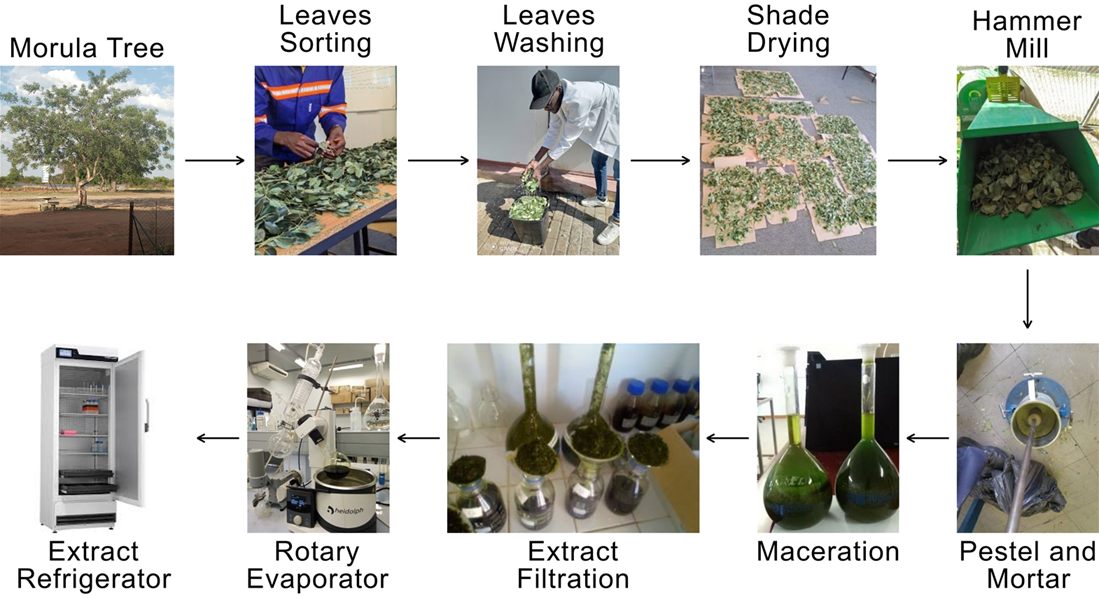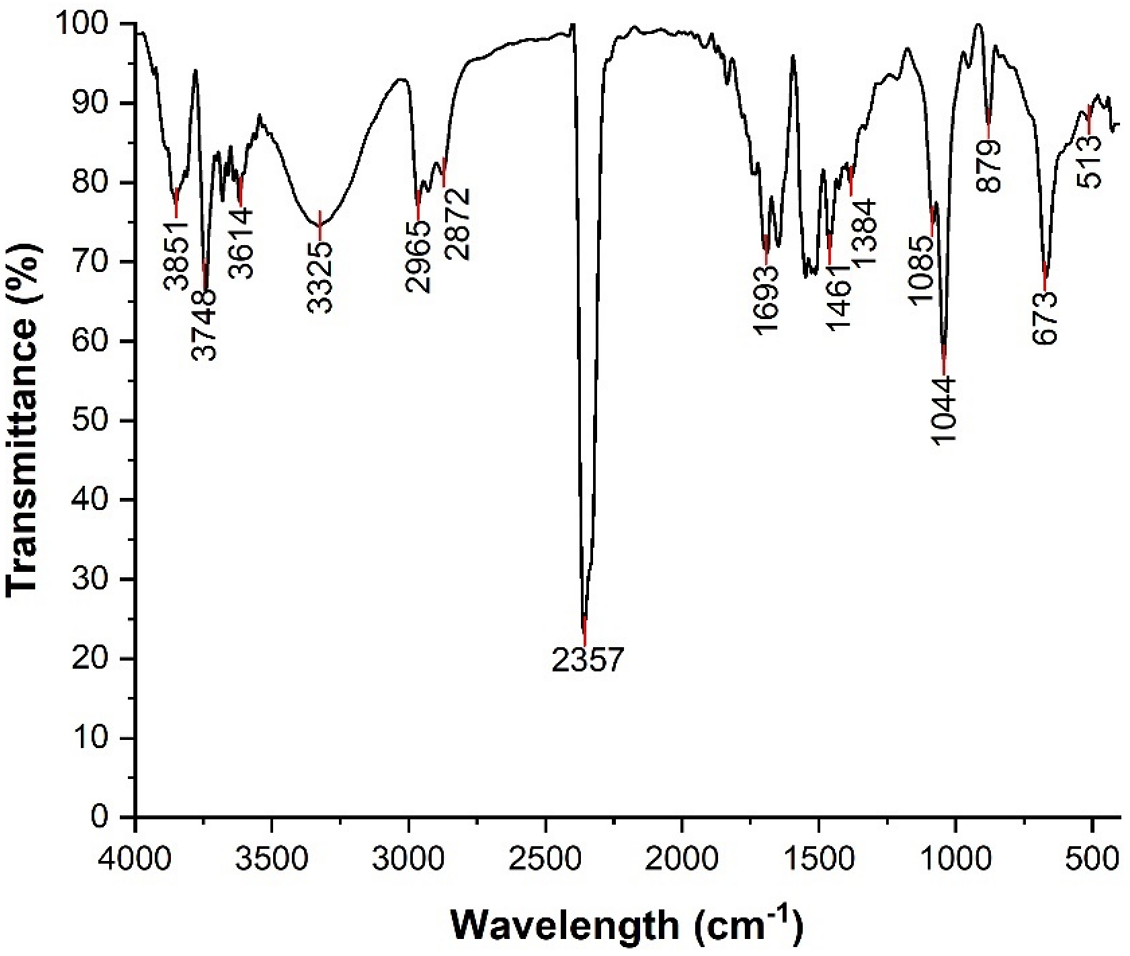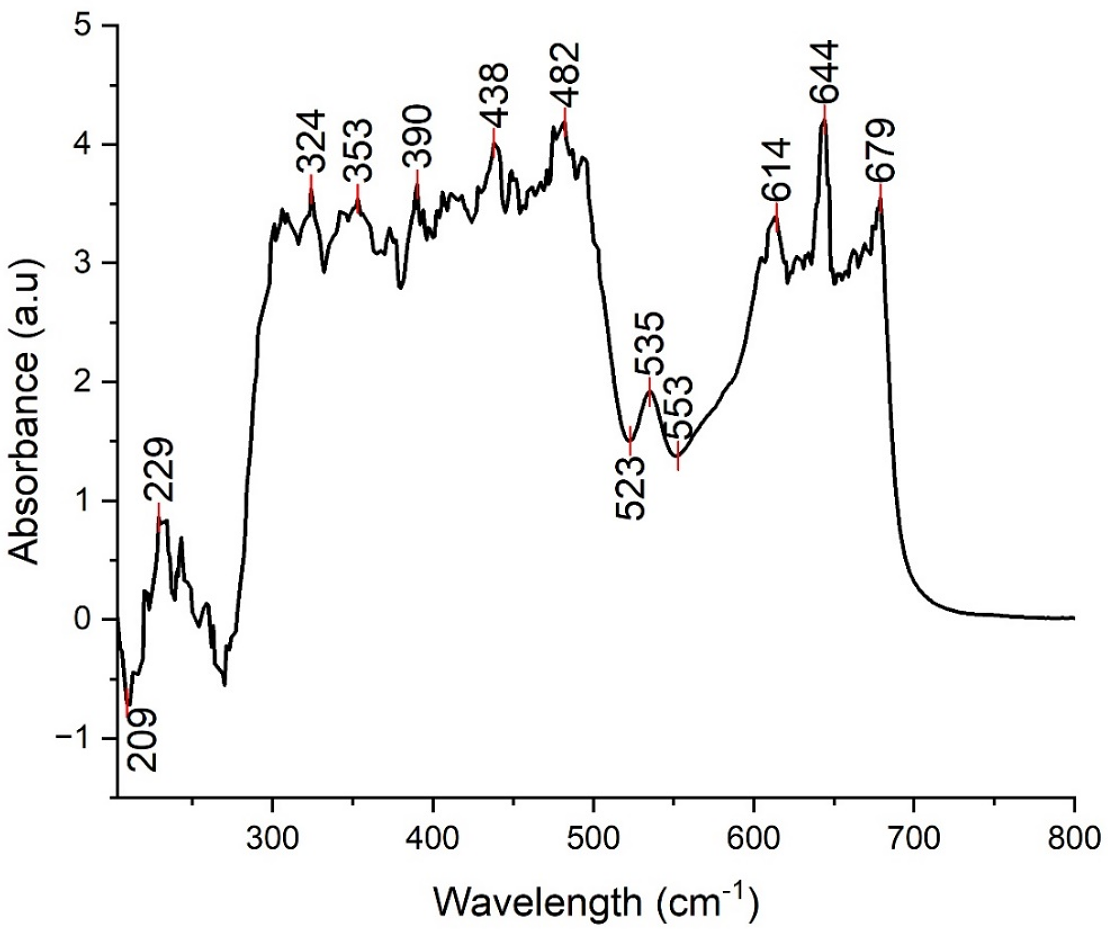Phytochemical characterization of Marula (Sclerocarya birrea) ethanolic leaf extract: A Precursor for Green Corrosion Inhibitor Development
by Phenyo Shathani ★ , Enoch Nifise Ogunmuyiwa , Babatunde Abiodun Obadele , Oluseyi Philip Oladijo
Academic editor:
Sciences of Phytochemistry 4(2): 91-97 (2025); https://doi.org/10.58920/sciphy0402334
This article is licensed under the Creative Commons Attribution (CC BY) 4.0 International License.
28 Apr 2025
21 Aug 2025
27 Aug 2025
03 Sep 2025
Abstract: In the search for environmentally friendly corrosion inhibitors, medicinal plants rich in various phytochemicals present promising options due to their natural ability to adsorb onto metal surfaces, forming protective barriers against corrosive agents. This study examines the phytochemical profile of the ethanolic extract of Sclerocarya birrea using Fourier Transform Infrared Spectroscopy (FTIR), Ultraviolet-Visible (UV-Vis) spectroscopy, and Gas Chromatography-Mass Spectrometry (GC-MS). The UV-Vis spectrum displayed distinct absorption peaks characteristic of the extract’s components. FTIR analysis confirmed the presence of functional groups associated with alkanes, alkenes, phenols, amines, aromatics, esters, ketones, and aldehydes. GC-MS detected 17 phytochemical compounds, including notable components such as γ-sitosterol (39.44%), l-(+)-ascorbic acid 2,6-dihexadecanoate (17.37%), pagicerine (14.66%), hexadecanoic acid derivatives (10.45%), octadecanoic acid (4.34%), and phytol (3.46%). These compounds are known for their medicinal properties and chemical structures that support effective corrosion inhibition. The phytochemicals primarily contribute to corrosion protection by adsorbing onto metal surfaces, creating protective films that impede both anodic and cathodic reactions, thus reducing metal dissolution and increasing resistance. The detailed phytochemical analysis provides a solid basis for further research into S. birrea as a sustainable and effective corrosion inhibitor for various metals in different corrosive environments. This work emphasizes the extract’s potential as an environmentally friendly alternative to traditional synthetic inhibitors.
Keywords: Spectroscopic characterizationOrganic functional groupsNatural antioxidantsSurface passivationProtective film formationSustainable materials
Introduction
In recent years, medicinal plants have gained prominence in the field of green corrosion inhibition of metallic materials in various aggressive environments. Green inhibitors are increasingly favored over synthetic alternatives due to their environmental friendliness, biodegradability, and cost-effectiveness, which mitigate issues related to the toxicity and persistence of synthetic compounds (1). Plant extracts are rich in phytochemicals containing functional groups and heteroatoms that adsorb on metal surfaces, forming protective barriers that hinder corrosion (2). The plant leaf extracts have proven to be one of the most effective components, with various studies reporting high inhibition efficiencies in a range of corrosive environments.
Leaves represent the wealthiest part of plants in organic compounds, as they are the primary site of synthesis via photosynthesis, producing a diverse array of bioactive molecules (3). They are also widely available and easily accessible, which ensures a consistent and sustainable supply for inhibitor production. Leaves dry quickly, are easily ground into a fine powder, and yield reproducible extracts with high surface-active phytochemicals. Moreover, leaves are often abundant in active constituents, including tannin, polyphenol, flavonoid, and alkaloid compounds, well recognized for their affinity to adsorb onto metal surfaces, thereby forming protective film barriers that effectively inhibit corrosion.
For a plant leaf extract to be considered a corrosion inhibitor, it must be characterized to confirm the presence of heteroatoms, polar functional groups, aromatic rings, and other relevant phytochemicals known to interact with metals (4). While the presence of these compounds suggests inhibitory potential, further research is necessary to elucidate their mechanistic roles from kinetic and thermodynamic perspectives. Medicinal plant leaf extracts have recently attracted substantial interest for their potential application as a protective coating for metallic surfaces in various settings. These recently studied plant leaves for corrosion inhibition include the following: Arbutus unedo (5), Falcaria vulgaris (6), Terminalia arjuna (7), Acanthopanax senticosus (8), Artabotrytis odoratissimus (9), and Dalbergia odorifera (10).
The native Sclerocarya birrea is also referred to as the marula tree, which is a drought-resistant species widely distributed in Africa, but mostly in sub-Saharan Africa (11). It is known to be a particularly salt-tolerant tree that may exceed 18 meters in height, featuring a trunk diameter of 120 cm, grey bark, and secondary roots that potentially span 30 meters. Marula trees grow well in sandy, stony, or sandy loam soils with yearly precipitation ranging from 200 to 1370 mm (12). Marula is a versatile tree because of its nutritional value extracted from the fruit, cosmetic oil from the seed, which includes high fat, citric acid, protein, malic acid, phosphorus, and zinc, among others, and therapeutic value from the bark and leaves (13).
Numerous studies have focused on the critical components of marula trees that contribute to their therapeutic effects (14). S. birrea has been extensively studied for its anti-diabetic, anti-inflammatory, analgesic, antiparasitic, antibacterial, and antihypertensive effects (15). This led to the analysis of the phytochemical substances present in the various parts of the tree, depending on which portion of the tree is of interest at the time, as phytochemicals are typically thought to have therapeutic properties that can bring healing (16). There are polyphenols, tannins, flavonoids, alkaloids, anthocyanins, and substantial quantities of saponosides. Quercetin and its derivatives also contain tannins (mostly procyanidins), triterpenoids, polyphenols, phytosterols, organic acids (gallic and quinic), and other flavonoids (17), which have been reported in various literature to aid in corrosion inhibition.
Despite the documented phytochemical richness and medicinal applications of S. birrea, its leaf extract remains underexplored in terms of phytochemical characterization relevant to corrosion inhibition. This study addresses this gap by analyzing ethanol-extracted S. birrea leaves using Fourier Transform Infrared Spectroscopy (FTIR), Ultraviolet-Visible (UV-Vis) spectroscopy, and Gas Chromatography-Mass Spectrometry (GC-MS) to identify functional groups and bioactive constituents. By elucidating the phytochemical profile, this work aims to establish the potential of S. birrea as a sustainable and effective green corrosion inhibitor, providing a foundation for future corrosion control applications.
Experimental Section
Preparation of Plant Leaf Extract
S. birrea leaves were collected near the Department of Engineering at Botswana International University of Science and Technology (BIUST), Botswana, and authenticated by a BIUST botanist. Mature, healthy leaves were selected, washed 2–3 times to remove impurities, and shade-dried naturally at ambient temperature for 10 days to preserve heat-sensitive phytochemicals. The dried leaves were milled using a hammer mill and ground to a fine powder to enhance ethanol penetration during extraction.
Extraction was performed by maceration, with 500 g of leaf powder soaked in 2500 mL of analytical-grade (95%) ethanol (solvent-to-sample ratio 5:1) for 72 h under periodic agitation. The solvent-to-sample ratio of 5:1 (2500 mL of ethanol to 500 g of powdered leaves) was selected based on preliminary optimization trials, which indicated that this ratio ensured the efficient solubilization of phytochemicals while preventing solvent saturation. Ratios significantly lower than this led to incomplete extraction, while higher ratios did not yield additional phytochemical benefits but unnecessarily increased solvent use. This ratio was chosen based on preliminary trials and relevant literature to ensure efficient phytochemical extraction while maintaining solvent economy (18, 19). The mixture was filtered using Whatman No. 1 filter paper over 24 h to obtain a homogeneous solution. This was then concentrated via rotary evaporation at 40 °C and 100 rpm to yield a thick slurry. The extract was stored at 4 °C in an airtight container before subsequent analyses. A summary of the S. birrea ethanol extract preparation is displayed in Figure 1 below.
Fourier Transform Infrared spectroscopy (FTIR) Analysis
The S. birrea ethanolic extract and powdered leaf samples were analyzed using a Bruker Vortex 70 V vacuum FTIR spectrometer (Bruker, China) to identify and characterize functional groups. Samples were placed directly into the FTIR sample holder, and spectra were acquired in transmittance mode over the range of 4000 to 400 cm⁻¹ at room temperature (27 °C). The spectral resolution was set to 4 cm⁻¹, and each spectrum was averaged over 32 scans toenhance signal quality. Characteristic functional groups were assigned based on distinct absorption peaks in the recorded spectra.

Ultra-Violet Visible Spectroscopy (UV-Vis) Analysis
Ultraviolet-visible (UV-Vis) spectroscopy analysis of the S. birrea ethanolic extract was performed using a PerkinElmer Lambda 75 double-beam spectrophotometer (PerkinElmer, USA) to identify characteristic chromophoric groups indicative of phytochemicals. Spectra were recorded at room temperature over the wavelength range of 200 to 800 nm, using quartz cuvettes with a 1 cm path length. Ethanol was employed as a blank reference to correct for solvent absorbance. The spectral bandwidth was set at 1 nm, with a scanning speed of 400 nm/min, ensuring accurate detection of absorption peaks. Interpretation of the spectra involved examining characteristic absorption bands and comparing them against standard reference spectra and literature data to confirm the presence of functional groups such as phenols, flavonoids, and other bioactive compounds relevant to corrosion inhibition.
Gas Chromatography – Mass Spectroscopy (GC-MS) Analysis
The phytochemical profile of the S. birrea ethanolic extract was analyzed using a Shimadzu GC-MS-QP2010 Ultra system (Shimadzu, Japan) equipped with a fused silica capillary column (30 m × 0.25 mm internal diameter × 0.25 μm film thickness. Helium served as the carrier gas at a constant flow rate of 1.0 mL/min. A 1 μL sample was injected in splitless mode with the injector temperature set at 250 °C. The oven temperature program started at 70 °C (held for 1 minute), ramped at 10 °C/min to 200 °C (held isothermal for 1 minute), then increased at 10 °C/min to 250 °C. The interface temperature was maintained at 250 °C (20). ). Mass spectra of the compounds were taken by electron ionization at 70eV. The experimental steps were examined within the 40–600 m/z range at intervals of 0.5 s. To ensure the reliability of the results, blank runs using pure ethanol were performed before sample analysis to account for any background signals or contaminants originating from the solvent or instrument. The chromatogram data were analyzed and cross-referenced with the Wiley Spectral library search engines.
Results and Discussion
The ethanolic leaf extract was analyzed using GC-MS, FTIR, and UV-Vis to determine the phytochemical compounds, organic compounds, and functional groups present that aid in inhibiting metal corrosion in corrosive media.
FTIR Analysis
The FTIR spectra analysis revealed distinct characteristic peak values of different functional groups found in ethanolic S. birrea leaf extract (Figure 2). Furthermore, the functional groups were detected at other bands and are attributed to phytochemical compounds, such as tannins, saponins, alkaloids, anthraquinones, and flavonoids, that are found in this noble tree leaf.
Meanwhile, Table 1 below displays a range of distinct peaks at specific wavenumbers. These peaks correspond to vibrational modes associated with different functional groups, providing insight into the molecular composition of the extract. The most prominent peaks are 3851, 3748, 1693, 1044, and 673 cm-1, which indicate O-H stretching vibrations and the presence of alcohols or phenols.

No. | Bond | Functional Group | Peak value |
1. | O-H | Alcohol | 3851 |
2. | COOH | Carboxylic acid | 3748 |
3. | C-H | Aromatic | 3614 |
4. | N-H | Primary amine | 3325 |
5. | C-H | alkane | 2965 |
6. | C-H | aldehydes or ketones | 2872 |
7. | C≡C | Amine | 2357 |
8. | C=O | Ketone | 1693 |
9. | C-H | Alkane | 1461 |
10. | C=C | Alkene | 1384 |
11. | C-O | Ester | 1085 |
12. | C-H | Out-of-plane bend in aromatic compounds. | 1044 |
13. | C-Cl | Alkyl chlorides | 879 |
14. | C-Br | Alkyl bromides | 673 |
15. | C-I | Alkyl iodides | 513 |
16. | C-O | Ether | 496 |
Prominent peaks observed at 3851 and 3748 cm⁻¹ are attributed to O–H stretching vibrations, indicating the presence of alcohols and phenolic compounds, which are known for their antioxidant and corrosion-preventive properties. Aliphatic C–H stretching vibrations at 2965 and 1461 cm⁻¹ suggest alkane structures within the extract. The strong carbonyl stretching peak at 1693 cm⁻¹ corresponds to aldehydes, ketones, or esters, while the band at 1384 cm⁻¹ indicates C=C double bonds characteristic of alkenes. The presence of amines or amides is suggested by C–N stretching vibrations near 3325 cm⁻¹, and aromatic compounds are supported by benzene ring bending at 1044 cm⁻¹.
Notably, peaks assigned to halogenated functional groups (C–Cl at 879 cm⁻¹, C–Br at 673 cm⁻¹, and C–I at 5130 cm⁻¹) were detected. Given the natural origin of the extract and the absence of halogenated solvents during extraction, these signals likely stem from trace laboratory contamination or environmental sources rather than inherent chemical constituents.
Overall, these results reveal a diverse range of functional groups, offering a comprehensive understanding of the chemical composition of S. birrea leaf extract. Alcohols, phenols, alkanes, alkynes, carbonyls, alkenes, amines or amides, and aromatic chemicals have all been identified to contribute to the extract's complexity (21). Phenolic compounds are renowned for their corrosion-prevention capabilities (22) and have been discovered to be present in the S. birrea extract based on the O-H stretching vibrations observed in the FTIR spectrum. These compounds have the potential to absorb onto the metallic surface and generate a thin-film coating, inhibiting the oxidation-reduction process and shielding the metal, therefore impeding corrosion processes (23, 24). Furthermore, phenols contain heteroatoms (nitrogen, oxygen, sulphur, and so on) that protonate in solutions, donating lone electron pairs, double or triple bonds, and planar conjugated systems with various aromatic cycles in their structures, and that contribute to their effectiveness as corrosion inhibitors (25).
UV-Vis Analysis
UV-Vis spectroscopy was used to detect and identify the phytoconstituent profile of S. birrea extract, as shown in the spectrum above (Figure 3). This analysis was conducted to identify compounds containing σ bonds, π bonds, lone pairs of electrons, chromophores, and aromatic rings, all of which are known to contribute significantly to corrosion inhibition due to their electronic and structural properties. The presence of such features suggests the potential of the extract to adsorb onto the metal surface, thereby forming a protective barrier that mitigates the corrosive interaction between the metal and its environment (26). The spectral range was set between 200 and 800 nm to achieve distinct peak sharpness and a clear, stable baseline necessary for precise interpretation. However, the UV-Vis spectrum of the ethanolic extract of S. birrea, as detailed in Table 2, exhibits absorption within the wavelength range of 209–679 nm.
The absorption peaks observed in the 200–400 nm region indicate the presence of unsaturated moieties and heteroatoms, such as sulfur, nitrogen, and oxygen, which are typically involved in π-π and n-π electronic transitions (27). Prominent bands at 229–324 nm correspond to π-π* transitions in conjugated double bonds and aromatic rings, while absorptions at 353–425 nm are attributed to n-π* transitions associated with carbonyl and hydroxyl-containing chromophores. Peaks between 239 and 679 nm in the spectrum profile indicate the presence of phenolic chemicals and alkaloids (28). The π-π* transitions facilitate electron donation from delocalized π-electron systems of aromatic rings to vacant d-orbitals of the metal surface, promoting chemisorption (29,30). Similarly, n-π* transitions reflect the role of lone-pair electrons on heteroatoms (O, N) in coordinating with metal centers, thereby strengthening surface interactions (31). Thus, the observed spectral profile not only confirms the complex phytochemical composition of the extract but also directly supports its potential to form protective films on metallic substrates through electronic transitions that enable adsorption and surface passivation.

No | Wavelength (nm) | Absorbance (a.u) |
1. | 209 | 0.001399654 |
2. | 229 | 0.311306404 |
3. | 239 | 0.180704354 |
4. | 270 | 0.063772838 |
5. | 307 | 0.835008062 |
6. | 324 | 0.876372136 |
7. | 353 | 0.864873572 |
8. | 381 | 0.721332439 |
9. | 390 | 0.883084852 |
10. | 402 | 0.753459239 |
11. | 425 | 0.833893528 |
12. | 438 | 0.952784449 |
13. | 482 | 0.994375441 |
14. | 523 | 0.452774494 |
15. | 535 | 0.531942979 |
16. | 552 | 0.432929827 |
17. | 614 | 0.830348781 |
18. | 621 | 0.720826868 |
19. | 644 | 0.995859163 |
20. | 679 | 0.860618401 |
GC-MS Analysis
The GC-MS analysis of an ethanolic extract of S. birrea was conducted over 60 60-minute run time, with a 5-minute delay to identify the volatile and semi-volatile phytochemical constituents (32). Mass spectrum of the phytochemical compounds detected in the leaf extract is displayed in Supplementary Figure 1. The components that have been found and the peak percentages that correspond to them are Dodecane (3.22 %), Nonadecane (3.09 %), Benzenaminium, 4-carboxy-N,N,N-trimethyl-, hydroxide, inner salt (1.84 %), Ethanol, 2-(octadecyloxy) (1.25 %), 3,7,11,15-Tetramethyl-2-hexadecen-1-ol (2.01 %), Lupan-3-ol, acetate (1.63 %), l-(+)-Ascorbic acid 2,6-dihexadecanoate (17.37%), Hexadecanoic acid, ethyl ester(10.34%), 1-Cyclopenten-3-one, 1-(1-cyclohexen-1-yl)-2-[(carboxyethyl)(cyano)methyl] (1.65 %), Phytol (3.46 %), β-N-Acetylneuraminic acid, methyl ester-2-methyl-7,9-methyl-boronate-3,8-di(trimethylsilyl) (9.18 %), Octadecanoic acid (4.34 %), Octadecanoic acid, ethyl ester(1.84 %), γ-Sitosterol (39.44 %), Pagicerine (14.66 %), 9,19-Cyclolanostane-3,7-diol, Hexadecanoic acid (10.45 %), 1-(hydroxymethyl)-1,2-ethanediyl ester (11.76 %).
The S. birrea ethanolic extract yielded 17 phytochemical compounds at varied retention durations, which are given in Supplementary Table 1. All these compounds were adequately characterized and identified after comparing their mass spectra to those in the main library. The spectral fingerprints of the compounds were cross-referenced with those found in the National Institute of Standards and Technology (NIST) and the Wiley 9.0 databases to ensure accurate identification. Additionally included were the molecular weight, molecular structure, retention time (RT), and percentage peak area of the active phytoconstituents.
Twelve of the seventeen phytochemical compounds identified in S. birrea leaf extract have been previously characterized for their corrosion inhibition properties. Notably, 3,7,11,15-tetramethyl-2-hexadecen-1-ol, a significant constituent, is known to form stable protective films on metal surfaces, effectively inhibiting mild steel corrosion through mixed-type inhibition with predominant anodic effects (33). Similarly, octadecanoic acid (stearic acid) and its derivatives, found in significant amounts in the extract, are well documented to reduce corrosion rates by forming chemisorbed protective layers on various metals (34). Hexadecanoic acid ethyl ester and l-(+)-ascorbic acid 2,6-dihexadecanoate also contribute to metal surface passivation, enhancing corrosion resistance by their adsorption behavior (35, 36).
Other compounds, such as phytol and pagicerine, though less commonly studied in corrosion contexts, may play supplementary roles due to their chemical structures conducive to surface adsorption and film formation (37). These phytochemicals act synergistically by adsorbing to metal surfaces and forming protective barriers that inhibit anodic dissolution and cathodic reactions, resulting in improved corrosion resistance. A comprehensive, detailed discussion of each compound’s specific literature and mechanism has been moved to the supplementary section to maintain focus and clarity in this main discussion. The biological activity of the detected compounds in S. birrea has also been reported in Supplementary Table 2.
Conclusions
This study demonstrates that S. birrea ethanolic leaf extract contains a diverse phytochemical profile characterized by key functional groups and bioactive compounds, such as phytol, octadecanoic acid, pagicerine, and γ-sitosterol, which collectively suggest strong potential as a green corrosion inhibitor. The abundance of oxygen- and nitrogen-containing groups, together with antioxidant and metal-coordinating compounds, underscores the extract’s potential to adsorb on metal surfaces and retard both anodic and cathodic reactions. These findings highlight the promise of S. birrea as an eco-friendly, plant-based alternative for sustainable corrosion protection. Further research assessing its inhibition efficiency under various environmental conditions, using electrochemical and surface analysis techniques, is warranted to confirm its practical applicability.
Abbreviations
FTIR= Fourier Transform Infrared Spectroscopy; UV-Vis= Ultraviolet-visible spectroscopy; GC-MS= Gas Chromatography Mass Spectroscopy; BIUST= Botswana International University of Science and Technology.
Declarations
Acknowledgment
The authors would like to express their sincere gratitude to the technicians from the Departments of Chemistry and Forensic Sciences, as well as Biology and Botanical Sciences in BIUST , for their invaluable assistance. Their expertise in equipment operation and data analysis significantly contributed to the successful completion of this research. We also acknowledge the support provided by the technical staff in facilitating access to specialized instruments and ensuring accurate interpretation of results. Their dedication and professionalism have been instrumental in advancing our study.
Ethics Statement
Not relevant
Supplemental Material
Supplementary data associated with this article can be found in the online version at https://etflin.com/file/document/20250826053009326237802.docx
Data Availability
The unpublished data is available upon request to the corresponding author.
Funding Information
This is an initiation grant funded by the Botswana International University of Science and Technology (BIUST) with grant number S00452 for postgraduate students to facilitate their experimental works and research in general.
Conflict of Interest
The authors declare no conflicting interest.
References
- Zakeri A, Bahmani E, Aghdam ASR. Plant extracts as sustainable and green corrosion inhibitors for protection of ferrous metals in corrosive media: A mini review. Vol. 5, Corrosion Communications. Elsevier B.V.; 2022. p. 25–38.
- Zhao T, Zhou L, Li Z, Wang Z, Shang B. Diphenyl disulfide derivatives as high-efficiency corrosion inhibitors for copper in sulfuric acid: Experimental and theoretical studies. Colloids Surf A Physicochem Eng Asp. 2025 Jan;705:135751.
- Verma C, Ebenso EE, Bahadur I, Quraishi MA. An overview on plant extracts as environmental sustainable and green corrosion inhibitors for metals and alloys in aggressive corrosive media. J Mol Liq. 2018 Sep;266:577–590.
- Tan B, Liu Y, Ren H, Gong Z, Li X, Li W, et al. N, S-carbon quantum dots as inhibitor in pickling process of heat exchangers for enhanced performance in multi-stage flash seawater desalination. Desalination. 2024 Oct;589:117969.
- Abdelaziz S, Benamira M, Messaadia L, Boughoues Y, Lahmar H, Boudjerda A. Green corrosion inhibition of mild steel in HCl medium using leaves extract of Arbutus unedo L. plant: An experimental and computational approach. Colloids Surf A Physicochem Eng Asp. 2021 Jun 20;619:126496.
- Alimohammadi M, Ghaderi M, Ramazani S.A A, Mahdavian M. Falcaria vulgaris leaves extract as an eco-friendly corrosion inhibitor for mild steel in hydrochloric acid media. Sci Rep. 2023 Dec 1;13(1):3737.
- Hossain N, Chowdhury MA, Rana M, Hassan M, Islam S. Terminalia arjuna leaves extract as green corrosion inhibitor for mild steel in HCl solution. Results in Engineering. 2022 Jun 1;14:100438.
- Liao B, Luo Z, Wan S, Chen L. Insight into the anti-corrosion performance of Acanthopanax senticosus leaf extract as eco-friendly corrosion inhibitor for carbon steel in acidic medium. Journal of Industrial and Engineering Chemistry. 2023 Jan 25;117:238–246.
- Rathod MR, Minagalavar RL, Rajappa SK. Effect of Artabotrys odoratissimus extract as an environmentally sustainable inhibitor for mild steel corrosion in 0.5 M H2SO4 media. Journal of the Indian Chemical Society. 2022 May 1;99(5):100445.
- Tan B, Fu A, Guo L, Ran Y, Xiong J, Marzouki R, et al. Insight into anti-corrosion mechanism of Dalbergia odorifera leaves extract as a biodegradable inhibitor for X70 steel in sulfuric acid medium. Ind Crops Prod. 2023 Apr;194:116106.
- Mashau ME, Kgatla TE, Makhado MV, Mikasi MS, Ramashia SE. Nutritional composition, polyphenolic compounds and biological activities of marula fruit ( Sclerocarya birrea ) with its potential food applications: a review. Int J Food Prop. 2022 Dec 31;25(1):1549–1575.
- Tapiwa Kugedera A, Wildl Biodivers J, Andrew Tapiwa K. Harvesting and utilization of Marula (Sclerocarya birrea) by Smallholder farmers: A review. JOJ Wildl Biodivers. 2019;1(3):76-79.
- Legodi LM, Lekganyane MA, Moganedi KLM. Morula Tree: From Fruit to Wine through Spontaneous Fermentation and the Potential of Deriving Other Value-Added Products. Processes. 2022 Aug 27;10(9):1706.
- Prinsloo G, Street RA. Marula [ Sclerocarya birrea (A.Rich) Hochst]: A Review of Traditional Uses, Phytochemistry, and Pharmacology. In: African Natural Plant Products. 2013. p. 19–32.
- Mariod AA, Abdelwahab SI. Sclerocarya birrea (Marula), An African Tree of Nutritional and Medicinal Uses: A Review. Food Reviews International. 2012 Oct;28(4):375–388.
- Bai FW, Zhao XQ, Xu J. Immobilization Technology. In: Comprehensive Biotechnology. Elsevier; 2011. p. 477–489.
- Belemtougri RG, Constantin B, Cognard C, Raymond G, Sawadogo L. Effects of Sclerocarya birrea (A. rich) hochst (anacardiaceae) leaf extracts on calcium signalling in cultured rat skeletal muscle cells. J Ethnopharmacol. 2001 Aug;76(3):247–252.
- Dewan SMR, Amin MN, Adnan T, Uddin SMN, Shahid-Ud-Daula AFM, Sarwar G, et al. Investigation of analgesic potential and in vitro antioxidant activity of two plants of Asteraceae family growing in Bangladesh. J Pharm Res. 2013 Jun;6(6):599–603.
- Tambun R, Bin Sofian AH, Haryanto B, Alexander V, Prima BT, Waruwu PR. Natural corrosion inhibitors derived from powder, concentrated extract and tannin of ketapang (Terminalia catappa L.) leaves for iron protection in sodium chloride solutions. Current Research in Green and Sustainable Chemistry. 2025;11:100471.
- Erban A, Martinez-Seidel F, Rajarathinam Y, Dethloff F, Orf I, Fehrle I, et al. Multiplexed Profiling and Data Processing Methods to Identify Temperature-Regulated Primary Metabolites Using Gas Chromatography Coupled to Mass Spectrometry. In 2020. p. 203–239.
- Muhamad II, Hassan ND, Mamat SNH, Nawi NM, Rashid WA, Tan NA. Extraction Technologies and Solvents of Phytocompounds From Plant Materials : Physicochemical Characterization and Identification of Ingredients and Bioactive Compounds From Plant Extract Using Various Instrumentations. In: Ingredients Extraction by Physicochemical Methods in Food. Elsevier; 2017. p. 523–560.
- Sesia R, Spriano S, Sangermano M, Ferraris S. Natural Polyphenols and the Corrosion Protection of Steel: Recent Advances and Future Perspectives for Green and Promising Strategies. Metals (Basel). 2023 Jun 3;13(6):1070.
- Loto RT. Anti-corrosion performance of the synergistic properties of benzenecarbonitrile and 5-bromovanillin on 1018 carbon steel in HCl environment. Sci Rep. 2017 Dec 14;7(1):17555.
- Lakshmi D. Corrosion Inhibition by Phenols-An Overview. Int J Nano Corros Sci Eng. 2016;3(1):1-18.
- Rani A, Aslam Mohd, Nand B, Pandey G, Singh P. Update on Pharmacological Drugs and Macrocyclic Compounds as Corrosion Inhibitors. ChemistrySelect. 2024 Nov 14;9(43):e202403762.
- Hossain N, Aminul Islam M, Asaduzzaman Chowdhury M. Advances of plant-extracted inhibitors in metal corrosion reduction – Future prospects and challenges. Results Chem. 2023;5:100883.
- Shi J, Tai M, Hou J, Qiao Y, Liu C, Zhou T, et al. Intramolecular D-A structure and n-π* transition co-promoted photodegradation activity of carbon nitride: Performance, mechanism and toxicity insight. Chem Eng J. 2023 Jan;456:141029.
- Karpagasundari C, Kulothungan S. Analysis of bioactive compounds in Physalis minima leaves using GC MS, HPLC, UV-VIS and FTIR techniques. J Pharmacogn Phytochem. 2014;3(4):196–201.
- Azeez YH, Mamand DM, Omer RA, Awla AH, Omar KA. Investigation of corrosion inhibition and adsorption properties of quinoxaline derivatives on metal surfaces through DFT and Monte Carlo simulations. Corros Rev. 2024 Dec 17;42(6):775–793.
- Anadebe VC, Lgaz H, Aldalbahi A, Lee H, Mathias GE, Badeji AA, et al. Interfacial Inhibition of Mild Steel Corrosion by Abemaciclib and Abrocitinib in Acidic Media: Insights from Density Functional Theory and Molecular Dynamics Simulations. ChemistrySelect. 2025 Aug 18;10(32):e03502.
- Idlahoussaine N, El Ibrahimi B, Ait Addi A, Daoudi W, Idouhli R, Lasri M, et al. Investigating the effectiveness of an imidazopyridine-based compound as an anti-corrosive additive for mild steel in molar hydrochloric acid solutions: a mutual multi-facet experimental and computational approach. Phys Chem Chem Phys. 2025;27(21):11144–11161.
- Kobarfard M, Sweett A, Hansson J, Parker B, Górecki T. Development and Optimization of a Gas Chromatography–Mass Spectrometry Analytical Method for Detecting Sulfolane and Benzene Toluene, Ethylbenzene, and Xylenes in Water Samples. Separations. 2025 May 15;12(5):127.
- AT JR, Arshad M, Kuruvilla M, Joseph A. Computational modelling and correlation of physical parameters of 1-heptatriacotanol, phytol and 3, 7, 11, 15-tetra methyl-2-hexadecen-1-ol with the corrosion inhibition efficiency of CIW for mild steel in HCl. Corros Eng Sci Technol. 2023 Apr 3;58(3):243–258.
- Eddy NO, Ameh PO, Odiongenyi AO. Physicochemical Characterization and Corrosion Inhibition Potential of Ficus Benjamina (FB) Gumfor Aluminum in 0.1 M H2SO4. Port Electrochim Acta. 2014;32(3):183–179.
- Irwan, Fuadi A, Suhendrayatna. Investigation of Ascorbic Acid as Environment-Friendly Corrosion Inhibitor of Low Carbon Steel in Marine Environment. IOP Conf Ser Mater Sci Eng. 2019 Jun 1;536(1):012108.
- Brixi NK, Sail L, Bezzar A. Application of ascorbic acid as green corrosion inhibitor of reinforced steel in concrete pore solutions contaminated with chlorides. J Adhes Sci Technol. 2022 Jun 3;36(11):1176–1199.
- Taj T, Sultana R, Shahin HD, Chakraborthy M, Gulzar Ahmed M. Phytol A Phytoconstituent, Its Chemistry And Pharmacological Actions. Gis Sci J. 2021;8:1–11.

 ETFLIN
Notification
ETFLIN
Notification







